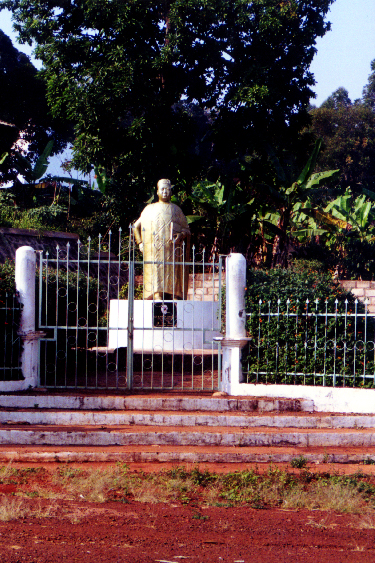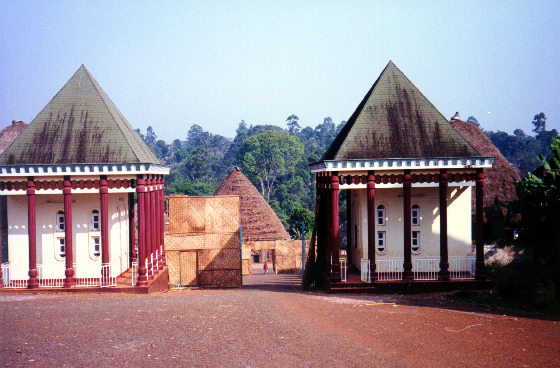Bandjoun

We’re heading to Bandjoun, about fifteen minutes ride from Batie. Once Becky finishes her photocopying and other to do items, we head over to the Chefferie. Bandjoun may be a pretty good sized town, but I don’t know how to tell if it is. Actually, I don’t know how to tell what any town here is in size.
Anyway the taxie reaches the Chefferie, and we immediately begin our tour. We find out during the tour that the Chefferie is usually placed at the bottom of a hill so that the Chief is able to look up at his land and people, to know what his responsibilities are. There’s also a system of nobility that is still recognized here, and it permeates all land owned by Bandjoun.
If you’ve ever heard of the “cone shaped” rooftops that are on some of the homes, you’ll soon find out they indicate the status of a noble. There could be anywhere from one to six of these type tops. Of course I’m wondering how one acquires such a status, and find out (from our tour guide) that its heriditary or bestowed upon one by the Chief, for great deeds that he may have done. Deeds for the community of course.
If you’re looking for lots of visual stimulation the Chefferie was not too exciting. But as long as you know french and like the stimulatin of receiving verbal history lessons, the experience is not one you want to pass up.
The tour of the main building (believe its known as the cheiftancy), included stories of secret societies and the desire to keep things as traditional as possible. The sculpture on this building alone was magnificent. Each of the supporting poles kind of gave a history of the Bandjoun people, who actually received they’re name when Europeans began to make their way in this part of central Africa. Originally, the native people of this area referred to them as “paichou,” which meant people who buy. So much has happened like that in the world’s history.

Europeans making they’re way around the globe, claiming to do so in the name of expeditions and studies, only to gain the trust of those there and eventually betray them. How is it that so much of western history is tarred with such acts, and we in the present day world, with our sense of human rights, allow it to continue?
Yeah we say its for the benefit of those who need to move into “our” civilized-mode of thinking. But we’re talking people who are following they’re traditions of living at peace with the earth. There were no environmental imbalances, or endangered species before we “westerners” began to live the luxurious lives.
Why is it so hard for governments, of countries responsible for such atrocities, to apologize and provide reparations for the descendants of those originally affected? Did the Australian aboriginals deserve to be separated from families and treated like uncivilized people? Did the Africans deserve to be herded way to a foreign land and sold as property? Did the Native Americans deserve to be separated from their land and then ceremoniously given some of it back, as if that compensated them for the loss of hundreds of thousands?
Wake up people! There may be some of you who say, yeah but that was then, this is now, we’re not responsible for that. Yeah right! There are quite a few of the wealthy and corporate giants that directly benefited from such actions. What will happen when on the day we finally come face to face with extra-terrestrials who will treat us as many here have been treated? Enslaved and made to feel inferior, ashamed of your heritage and people?
Oops, how did I get on that “stump”?
Back to our regularly scheduled story. In the museum portion of the place, there’s a little make shift merchandise store. This consisted a few black folded plastic bags with postcards and a few soiled books on Bandjoun history and culture. However, the artifacts stored in were breath-taking.
If only the curators (so-to-speak) of this establishment would encase these objects so that the harshness of the humidity and rainy seasons don’t destroy them, others would be able to enjoy this history.
Finding a taxi when leaving the Chefferie is next to impossible, so plan on walking about two miles or so to reach “the road to Douala” where you can find a taxi more easily. Unless of course you either drive or make other arrangements for a ride.
On our return to Batie, I again wondered why some of the taxi’s here had the appearance they do. I can’t figure out why, for the life of me, why if Cameroonians are so stuck on how their dress appears, can’t they pay as much attention to how they’re mode of transportation appears? We’re talking some cars that would not even be allowed on the road in some countries. This particular taxi was kind of rickety; actually it was rickety and smelly. At times I wondered if it would make it up the hill.
Speaking of cars, there are a wide variety, though. Don’t think that everyone travels in sub-par vehicles. Far from it. I believe I’ve seen more Mercedes Benz here than I do in some of the major cities in the states. I can not believe that a people that can afford to live as lavishly as some of them do, are part of a country that is considered under-developed by the rest of the world.
It really appears as if mostly the taxis are kept in this manner. Well, when you think about it, some of the taxis in the states are also like this; nah, not this bad. Who wants to be in a car with someone when they don’t even have the engine on going down steep hills! What is this about saving gas? I know its like four dollars and change per liter, but do they have to act as if they’re tight wads about using it? Maybe so, but it doesn’t seem to make sense to me. Maybe this is their way of giving back to the universe; by keeping the environment clean and using less gas to do so. Right!
We arrived back at Becky’s house to find her entrance way adorned with flowers. Their were a bunch of neighborhood children in the front area standing, running around or skipping with big smiles on their faces. They had decorated the door of “Ms.” (the term used to refer to female instructors here).
It was a nice gesture, and one that showed these little children definitely loved “Ms.” Wow, how many of us would love to return home after a hard day and find a doorway decorated with flowers and pine, for no apparent reason?
Again playing tourists, we snapped photos then ventured inside to rest our feet from the day of walking. After about thirty minutes of attempting to relax by reading or gazing, there were knocks at the door. The children had returned to dance and sing for “Ms.” They had to be at the door for what seemed like twenty minutes or more. At one point, they even sung the Cameroonian national anthem; well, their rendition of it anyway.
While I read, Akilah and Becky prepared dinner, egg rolls and tabouleh. Who would’ve imagined coming to Cameroon to taste homemade egg rolls. Actually, half of what I’ve eaten here, I probably would not have taken the time to make at home; nonetheless imagined I’d be fixing or eating it here. Dinner was good. I finished my book (Brown girl in the ring, if you like science fiction and Octavia Butler, its highly recommended) as the two women made after dinner conversation.